
女包:原价850sFr,现价319sFr,再折扣30%,最后225sFr.

Bally经典帆布条小羊皮女包,原价480,现价229,不再折扣。

经典黑色长靴,超级合脚,穿着舒适轻松,原价850,现价249
 咖啡色半高跟女鞋,原价249,现价79
咖啡色半高跟女鞋,原价249,现价79 经典黑色高跟鞋,超级舒适,版型漂亮,原价400多,现价99
经典黑色高跟鞋,超级舒适,版型漂亮,原价400多,现价99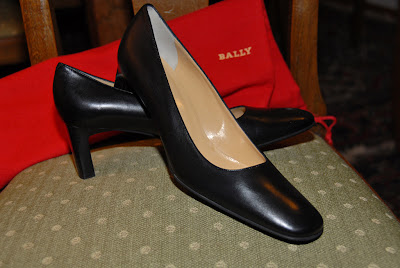 磨沙皮男鞋,原价400多,现价79
磨沙皮男鞋,原价400多,现价79 浅棕漆皮女鞋,平跟,配藏蓝色牛仔裤很漂亮,现价79
浅棕漆皮女鞋,平跟,配藏蓝色牛仔裤很漂亮,现价79 穿着特别舒适棕色软底男鞋,原价400多,现价79
穿着特别舒适棕色软底男鞋,原价400多,现价79
自己动手,丰衣足食

It will make your work much easier if you 'grid' the fabric before commencing cross stitch. This will take a little time, but is well worth the effort. Using a single strand of thread, Mark out a grid of tiny crosses, each two stitches high by two stitches wide, with the verticals and horizontals being ten rows apart, as shown below. Run your thread loosely from one cross to another at the back. Only mark these crosses in the area to be worked and not in the background, and make sure that you snip and remove each cross as you come to it when actually working the piece.

When using a single strand doubled over
Pull the thread from the skein, twice the length you desire for stitching - approximately one metre would be about right. Now select a single strand and pull it gently from the six. Double the strand and thread the two free ends through the needle as shown. Starting from the back of the fabric, stitch upwards through the fabric at the beginning of the first stitch, then down through the fabric in the hole diagonally up from the first hole to complete the first half of your cross. After pulling the needle through the fabric, pass it through the loop in your thread at the back of the fabric. Pull gently on the thread until it tightens onto the fabric without buckling. Now continue the row of half crosses.


When using one or more strands (including two strands that have been cut and have no loop)
There are two ways to start. One is to hold a length of thread 2.5 cm or 1 in at the back of the work and overstitch it as you stitch along the row. The diagram below shows what the reverse side of the work will look like.

Alternatively, you may prefer to tie a loose knot in the end of the thread and, commencing a short distance away from where your first stitch will start and in the direction you will be stitching, stitch downwards through the fabric leaving the knot on top of the fabric. Pass across to your starting point and begin stitching, oversewing the loose strand at the back of your work. Snip off the knot when you are satisfied that the thread at the back of the work is held securely in place.
Work half crosses, that is, bottom right to top left or bottom left to top right diagonal stitches along the row for the whole length of that area of colour, then stitch back in the opposite direction to work, left to right or right to left. The choice is yours, but it must be maintained consistently throughout the entire design.


Work each cross individually. This also applies when working a diagonal row.

The back of your work will consist of vertical rows of stitches. To finish off a thread neatly, stitch through these back-of-work stitches in a single vertical line, one stitch passing through to the right, the next one to the left and so on for four or five stitches. The work will not come undone, and your finishing off will scarcely be visible.

Backstitching is a form of highlighting, usually done using one strand of cotton only. There are cases, however, where two strands may be required. This will always be indicated on your chart. Backstitching is indicated on the chart by a heavier line that can be solid, dotted, dashed, wiggly, etc. indicating which shade of thread is required.
To start backstitching, run through a few stitches at the back of the work, finishing where you wish to commence, then re-stitch through the last stitch again.
Start backstitching by coming up through the fabric, then move forward one stitch on the right side. Go through the fabric, coming up again one stitch back from where you came up the first time; stitch down into the same hole you originally came up through. That is forward one on top of the fabric, backwards two below the fabric, forwards one on top, and so on along the line.


The diagrams below show how you work a half cross stitch, a quarter cross stitch and a three-quarter cross stitch.




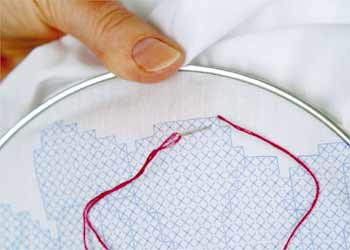
 Do a backstitch by bringing the needle up through one hole. Go backward over the indicated number of threads, then push the needle down through the appropriate hole in the fabric. Finally, bring the needle up the same number of threads ahead of your starting point. Repeat.
Do a backstitch by bringing the needle up through one hole. Go backward over the indicated number of threads, then push the needle down through the appropriate hole in the fabric. Finally, bring the needle up the same number of threads ahead of your starting point. Repeat.
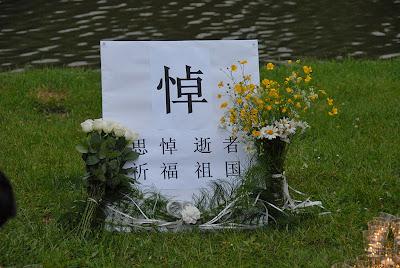 小蜡烛放入塑料杯中,用点火枪或引火棒点燃,按照模板摆成中国版图。
小蜡烛放入塑料杯中,用点火枪或引火棒点燃,按照模板摆成中国版图。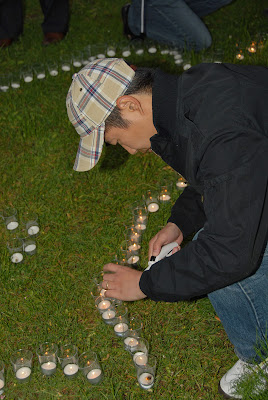
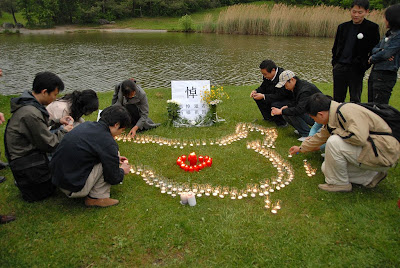 用红色蜡烛在中国版图的中心(恰好也是地震发生地带)摆成心形,代表我们的对灾区人民的挂念和对祖国的祝福。
用红色蜡烛在中国版图的中心(恰好也是地震发生地带)摆成心形,代表我们的对灾区人民的挂念和对祖国的祝福。 使用透明塑料水杯的本意是防止风吹灭蜡烛,却意外发现由杯子形成的折射散射却造成了很好的光学效果。
使用透明塑料水杯的本意是防止风吹灭蜡烛,却意外发现由杯子形成的折射散射却造成了很好的光学效果。
陆续前来的同胞点燃自己带来的各式各样的蜡烛,汇成美丽的画面,表达了我们的心意:四川,坚强!中国,加油!